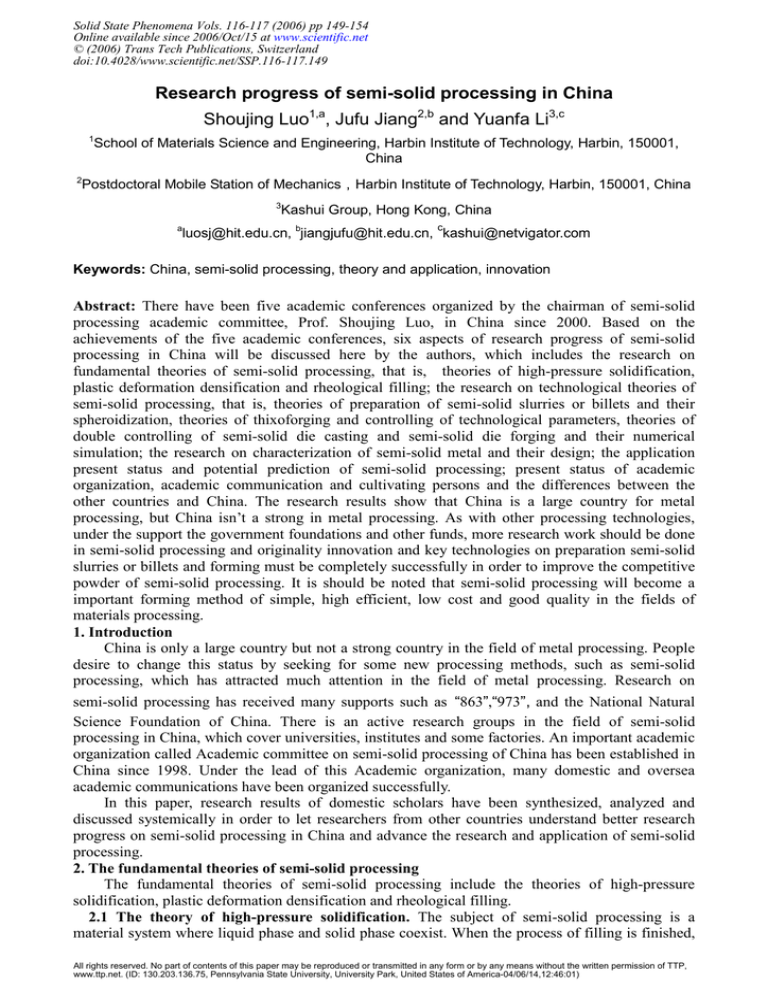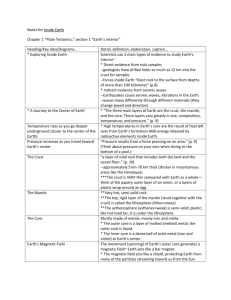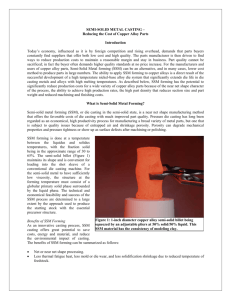
Solid State Phenomena Vols. 116-117 (2006) pp 149-154
Online available since 2006/Oct/15 at www.scientific.net
© (2006) Trans Tech Publications, Switzerland
doi:10.4028/www.scientific.net/SSP.116-117.149
Research progress of semi-solid processing in China
Shoujing Luo1,a, Jufu Jiang2,b and Yuanfa Li3,c
1
School of Materials Science and Engineering, Harbin Institute of Technology, Harbin, 150001,
China
2
Postdoctoral Mobile Station of MechanicsHarbin Institute of Technology, Harbin, 150001, China
3
Kashui Group, Hong Kong, China
luosj@hit.edu.cn, bjiangjufu@hit.edu.cn,ckashui@netvigator.com
a
Keywords: China, semi-solid processing, theory and application, innovation
Abstract: There have been five academic conferences organized by the chairman of semi-solid
processing academic committee, Prof. Shoujing Luo, in China since 2000. Based on the
achievements of the five academic conferences, six aspects of research progress of semi-solid
processing in China will be discussed here by the authors, which includes the research on
fundamental theories of semi-solid processing, that is, theories of high-pressure solidification,
plastic deformation densification and rheological filling; the research on technological theories of
semi-solid processing, that is, theories of preparation of semi-solid slurries or billets and their
spheroidization, theories of thixoforging and controlling of technological parameters, theories of
double controlling of semi-solid die casting and semi-solid die forging and their numerical
simulation; the research on characterization of semi-solid metal and their design; the application
present status and potential prediction of semi-solid processing; present status of academic
organization, academic communication and cultivating persons and the differences between the
other countries and China. The research results show that China is a large country for metal
processing, but China isn’t a strong in metal processing. As with other processing technologies,
under the support the government foundations and other funds, more research work should be done
in semi-solid processing and originality innovation and key technologies on preparation semi-solid
slurries or billets and forming must be completely successfully in order to improve the competitive
powder of semi-solid processing. It is should be noted that semi-solid processing will become a
important forming method of simple, high efficient, low cost and good quality in the fields of
materials processing.
1. Introduction
China is only a large country but not a strong country in the field of metal processing. People
desire to change this status by seeking for some new processing methods, such as semi-solid
processing, which has attracted much attention in the field of metal processing. Research on
semi-solid processing has received many supports such as 863,973and the National Natural
Science Foundation of China. There is an active research groups in the field of semi-solid
processing in China, which cover universities, institutes and some factories. An important academic
organization called Academic committee on semi-solid processing of China has been established in
China since 1998. Under the lead of this Academic organization, many domestic and oversea
academic communications have been organized successfully.
In this paper, research results of domestic scholars have been synthesized, analyzed and
discussed systemically in order to let researchers from other countries understand better research
progress on semi-solid processing in China and advance the research and application of semi-solid
processing.
2. The fundamental theories of semi-solid processing
The fundamental theories of semi-solid processing include the theories of high-pressure
solidification, plastic deformation densification and rheological filling.
2.1 The theory of high-pressure solidification. The subject of semi-solid processing is a
material system where liquid phase and solid phase coexist. When the process of filling is finished,
All rights reserved. No part of contents of this paper may be reproduced or transmitted in any form or by any means without the written permission of TTP,
www.ttp.net. (ID: 130.203.136.75, Pennsylvania State University, University Park, United States of America-04/06/14,12:46:01)
150
Semi-Solid Processing of Alloys and Composites
there is an effect of high-pressure solidification because liquid metal which has not been solidified
is suffered from isostatic pressure. Literature [1] describes thermodynamics model, the change of
thermodynamic parameters of metal and alloy, and the conditions of thermodynamics and dynamics
in the process of solidification under high-pressure solidification.
2.2 The theory of plastic deformation densification. Because of some flaws, such as shrinkage
porosity, may occur in the process of solidification, external force is required to eliminate these
drawbacks after the process of filling and solidification. Literature [1] has reported mechanical
analysis, theoretical calculation of longitudinal direction deformation degree, analytic solution of
specific pressure value, force-displacement curve and experimental observation of plastic
deformation, and so on. Moreover, the theory of mechanical deformation has also been established
in the process of semi-solid processing. In the Literature [2], mechanical model of plastic forming
has been given in semi-solid processing. Deformation behavior of solid skeleton has been described
by constitutive equations of continuous porous body and liquid flow has been described by Darcy
law. Finally, constitutive equations and Darcy law are coupled together. Based on these mentioned
above, viscoplasticity constitutive equations of semi-solid SiCp/2024 composite material have been
established [3], which can correctly describe deformation behavior of material during thixotropy
forming. Viscoplasticity constitutive equations of one-way isothermal axisymmetric compression
under semi-solid state have been established. The processes of semi-solid compressions at different
conditions have been simulated in order to disclosure the change regularity of equivalent stress and
equivalent strain [4].
In order to understand nature of semi-solid die forging, many domestic scholars have researched
the mechanical behaviors of compression conditions, including aluminum alloys [6-9], aluminum
matrix composites [10], magnesium alloys [11] and high-temperature alloy [12]. These research
results have showed that when solid phase particles are enclosed by liquid phase, the deformation of
material mainly depends on flow of single liquid phase or flow of liquid phase and solid phase
together; when solid phase particles contact each other, the deformation of material is treated as
sliding movement of among solid phase particle or plastic deformation of among solid phase
particle or both of them. However, after the process of semi-solid filling, the process of densify
needs to be depended on forming mechanism, which is characterized by sling movement of particle
and plastic deformation of particles themselves to realize.
2.3 The theory of rheological filling. The essence of semi-solid metal thixotropy can be
characterized by rheological character in the process of filling. The scholars in China have
researched the rheological characterizations of some alloys, such as aluminum alloys [13,14,15] and
composites [16,17]. They have obtained some meaningful results: the relationship between shear rate
and apparent viscosity is non-linear in the process of thixoforming of semi-solid aluminum alloys;
when shear rate reaches 2000s-1 ~10000s-1, slurry of semi-solid presents rheological character of
pseudo-plasticity; when shear rate is greater than 100000s-1, slurry of semi-solid presents
rheological character of rise-plasticity (570~580); At the same conditions of solid phase volume,
when the volume fraction of reinforcement is higher and refiner, its rheological character is better
than that of matrix.
3. The technological theories of semi-solid processing
3.1 Slurry (billet) making and the theory of spheroidization. Slurry (billet) marking should be
characterized by simple technique, low cost and excellent rheological character. Besides the
methods of electromagnetic stirring, shear –cooling roll (SCR) and cooling sloop, scholars in China
have also researched the methods of new strain-induded metal activation process [18], cooling slop
tube[19], electricity impulse and quick-cooling[20], grain refinement and semi-solid remelting[21] and
liquidus casting[22]. The essence of marking slurry (billet) includes grain refinement and
spheroidization, especially grain refinement or dendritic breaking, no matter the methods of liquid
or solid phase, which have been used to mark slurry (billet) of semi-solid state. The methods
mentioned above are put forward according to this mechanism. Moreover, these methods have been
verified by many experiments. The paper [14] has reported that for in the process of spheroidization,
Solid State Phenomena Vols. 116-117
151
increment in energy by methods such as stirring and grain breaking is helpful for formation of
spheroidization.
3.2 Process stabilization of semi-solid die casting. Semi-solid die casting, as with liquid die
casting, is characterized by high press and high rate. However, comparing with liquid die casting,
semi-solid die casting is characterized by high viscosity of slurry and low deformation temperature.
Xiangjie Yang, et al has researched running channel system [23], cavity filling rate [24] and cavity
filling ability [25]. It has demonstrated that: products produced by single running channel which has
sector with differential of an arc, have best mechanical properties; it is important to control metal
flow rate of gate ranging from 10 m/s to 15 m/s; thixotropic die casting has excellent filling cavity
ability and can meet the formation requirement of parts with complicated geometry.
3.3 Process stabilization of semi-solid die forging. Comparing with semi-solid die casting,
semi-solid die forging is characterized by low cavity filling rate, high-pressure solidification and
densify plastic deformation. However, semi-solid die casting does not have these three characters.
Semi-solid die forging is suitable for producing parts, which has not too complicated shape and wall
thickness of products are no less than 2 mm. Literature [26] has reported semi-solid processing
technological research of automotive piston. It has demonstrated that forming manner and
technological parameters have an important influence on process stabilization.
3.4 Double-control forming. Double-control forming is defined as a process in which shape of
the final product is controlled precisely, that is, controlling shape, and mechanical properties of the
final product are controlled precisely, that is, controlling performance. The principle of
double-control forming is based on easiness of semi-solid die casting for controlling shape of the
final product and easiness of semi-solid die forging for controlling mechanical properties of the
final product. Literature [27] presents that the principle of double-control forming is employed to
realize requirements for formation and performance of engine shell.
3.5 Numerical simulation of semi-solid processing. The numerical simulation of semi-solid
processing involves two aspects, numerical simulation of forming process of slurry with low
fraction solid and numerical simulation of forming process of slurry with high fraction solid. The
former mainly is done by researchers in the casting field, in which velocity field, temperature field
and flow field are described. However, the latter is done by researchers in the plastic forming field,
in which temperature field and stress-strain field under the condition of plastic flow can be
described. It has demonstrated that slurry with high fraction solid is suitable for semi-solid die
forging. Pressure, temperature and dwell time are important for filling and densification in
semi-solid die forging process. Furthermore, the mentioned above parameters must be optimized
according to different product.
4. The characteristic and alloy design of semi-solid
At present, aluminum alloys such as A356, A357 and AZ91D magnesium alloy have been
researched widely. Obviously, comparing with forging alloys, research on casting alloys is more.
Therefore, it is necessary to widen research on semi-solid materials.
Semi-solid materials have
been characterized by wide temperature interval between liquidus and solidus. Furthermore, the
forming temperatures of semi-solid materials have a limited influence on filling ability of slurry
[31,32]
. According to above principle, scholars in China have done many successful work in many
materials, including aluminum alloy such as high silicon alloys [33], 2618[34], 7075 [35], Al-20Sn [36],
SiCp/2A12 [10], and magnesium alloy like MB15, and iron alloy like 60Si2Mn [36]. It has
demonstrated that semi-solid materials are suitable for formation of both casting alloys and forging
alloys. Therefore, it is urgent to research on formation theory.
5. The present state and prediction of industrial application of semi-solid processing
Industrial application of semi-solid processing is at beginning stage in China. Literature [26],
[37] and [38] have reported alternately semi-solid processing has been successfully applied to
formation of many components such as connecting bar of automotive compression engine,
automotive aluminum piston, wheel hub of automobile with XX model number.The most difficulty
of industrial application is cost and quality. Both of them need to be linked. The deep reason is that
152
Semi-Solid Processing of Alloys and Composites
whether the technology of semi-solid processing is simple and sophisticated or not. Therefore, it is
necessary to transform research result into industrial application.
6. Academic communication and cultivating person
Semi-Solid Processing Academic Committee of Forging and Stamping Institution of Chinese
Mechanical Engineering Society has been established to organize academic communication in
China. Since 2000, two academic conferences have been held in Beijing. Since 2001, Semi-solid
Processing Academic Committee, Diecasting Committee of Casting Institution of Chinese
Mechanical Engineering Society and Squeeze Casting Committee of Material Institution of Chinese
Weapon and Engineering Society have organized three academic conferences together. In recent
years, scholars in China have actively participated in 8th international conference of semi-solid
processing. In this conference, three scholars in China have been elected additionally as members of
the International Scientific Committee on Semi-solid processing. The community in China has been
devoted to cultivating person in the field of semi-solid processing. Some universities, such as
Harbin Institute of Technology (HIT), Northwester Polytechnical University and Southeast
University, have advanced the progress of semi-solid processing, including introducing the
technology of semi-solid processing into classes, writing books about semi-solid processing, and
cultivating doctors, masters and undergraduates in the field of semi-solid processing. Especially, in
2005, the famous scholar from England professor H.V. Atkinson has been invited to of HIT of
China to give lectures about the technology of semi-solid processing in order to enhance person
cultivation and academic communication in the field of semi-solid processing.
7. Conclusions
The research on semi-solid processing in China has experienced the stages of initial starting,
establishing foundation and cultivating person. Now, it has run into the speedway, which is
characterized by the supports of National Natural Science Foundation of China (NSFC), project of
related ministries of Chin. Furthermore, more attention on semi-solid processing is paid by
enterprises and businesses and more application of semi-solid processing has occurred in enterprises.
In the future, the technology of semi-solid process will become a beautiful flower in the garden of
metal processing.
References
[1] Shoujing Luo, Shaoyuan He, Erde Wang, et al: Liquid Die Forging of Steel. (Harbin Institute of
Technology Press, China 1990)
[2] Shoujing LUO and Wentong Tian: Journal of Harbin Institute of Technology Vol.5 (2000), p. 78
[3] Lijun Zhu: Study on Thixoforming SiCp/2024 Composites in Semi-Solid State [D]. Ph.D.
Thesis, Harbin Institute of Technology, Harbin, China (2001)
[4] Wentong Tian: Semi-Solid Billet by SIMA and Research on Semi-Solid Forging For LC4 Alloy
Ph.D. Thesis, Harbin Institute of Technology, Harbin, China (2002)
[5] Jiakun Sun: Mechanical Behaviors and Mechanisms of Deformation of SiCp/2024Al
Composites at Semi-Solid State. Ph.D. Thesis, Harbin Institute of Technology, Harbin, P.R.
China (2005)
[6] Shoujing LUO and Jiakuan Sun: Chinese Science Bulletin Vol.3 (1999), p. 545
[7] Dahui Zhang, Weiming Mao, Xueyou Zhong, in: Shuisheng Xie, Shoujing Luo (Eds):
Proceedings of 1st seminar on semi-solid processing of alloy, Beijing, China, April, 2000, pp.
143-149
[8] Jun Guo, Zhiyong Ding, Shuisheng Xie, et al, in: Shuisheng Xie Shoujing Luo (Eds):
Proceedings of 1st seminar on semi-solid processing of alloy; Beijing, China, April, 2000, pp.
150-155
[9] Hongliang Yang, Itsuo Ohnaka Akira Sugiyama Tetsutaro Ohmichi, Zhiliang Zhang, in:
Shoujing Luo(Eds): Proceedings of The Symposium of 2003 Years Die Casting, Squeeze
Casting, Semi-Solid Processing in China; Shenzhen, China, April (2003), pp. 267-268
[10] Shoujing LUO, Lijun Zhu, Zhiming Du, in: Shuisheng Xie, Shoujing Luo (Eds): Proceedings
of The Symposium of 2001 Years Die Casting, Squeeze Casting, Semi-Solid Processing in
China; Yantai, China, August (2001), pp. 145-147
Solid State Phenomena Vols. 116-117
153
[11] Weiwei Shai, Jufu Jiang, Shoujing Luo, in: Zhengguo Yuan (Eds): Proceedings of The
Symposium of 2005 Years Die Casting, Squeeze Casting, Semi-solid Processing in China;
Ningbo, China, August (2005), pp. 205-207
[12] Renbo Song, Yonlin Kang, Xiongfei Yang, et al. : Chinese Journal of Materials Research, Vol. 4
(2000), pp. 591
[13] Xiangjie Yang: The Research on Thixoforming Deformation and Rheological Behavior and
Running Channel System Ph.D. Thesis, Shanghai University, Shangha, China (1999)
[14] Tao Li, Xin Lin, Linlin Wang, et al, in: Shoujing Luo(Eds): Proceedings of The Symposium of
2003 Years Die Casting, Squeeze Casting, Semi-Solid Processing in China; Shenzhen, China,
April (2003), pp. 322-327
[15] Aimin Zhao, Weimin Mao, Zisheng Zhen, et al, in: Shuisheng Xie, Shoujing Luo (Eds):
Proceedings of The Symposium of 2001 Years Die Casting, Squeeze Casting, Semi-Solid
Processing in China; Yantai, China, August (2001), pp. 242-246
[16] Shoujing Luo, Jufu Jiang, Ying Wang et al, in: Shuisheng Xie, Shoujing Luo (Eds):
Proceedings of 2st seminar on semi-solid processing of alloy; Beijing, China, November (2002),
pp. 54-59
[17] Xiannian Zhang, Henghua Zhang, Guangjie Shao, et al, in: Zhengguo Yuan (Eds): Proceedings
of The Symposium of 2005 Years Die Casting, Squeeze Casting, Semi-solid Processing in China;
Ningbo, China, August (2005), pp. 272-274
[18] Jufu Jiang, Shoujing LUO, Weiwei Shan, in: Zhengguo Yuan (Eds): Proceedings of The
Symposium of 2005 Years Die Casting, Squeeze Casting, Semi-solid Processing in China;
Ningbo, China, August (2005), pp. 208-213
[19] Weihua Cai, Xiangjie Yang, Hongmin Guo, et al, , in: Shuisheng Xie, Shoujing Luo (Eds):
Proceedings of 2st seminar on semi-solid processing of alloy; Beijing, China, November (2002),
pp. 308-310
[20] Guang’an Zhang, Zhiming Du, Jingpi Li, in: Shuisheng Xie, Shoujing Luo (Eds): Proceedings
of 2st seminar on semi-solid processing of alloy; Beijing, China, November (2002), p. 314-315
[21] Mingfang Zhu. Huaqin Su Casting (1996), p. 1
[22] Guimin Lu, Jie Dong, Jiangzhong Cui, in: Shuisheng Xie, Shoujing Luo (Eds): Proceedings of
The Symposium of 2001 Years Die Casting, Squeeze Casting, Semi-Solid Processing in China;
Yantai, China, August (2001), pp. 221-223
[23] Xiangjie Yang, Shuisheng Xie, Jin Liu, in: Shuisheng Xie Shoujing Luo (Eds): Proceedings of
1st seminar on semi-solid processing of alloy; Beijing, China, April (2000), pp. 128-133
[24] Xiangjie Yang, Shuisheng Xie, Jin Liu, in: Shuisheng Xie Shoujing Luo (Eds): Proceedings of
1st seminar on semi-solid processing of alloy; Beijing, China, April (2000), pp. 134-137
[25] Xiangjie Yang, Shuisheng Xie, Jin Liu, in: Shuisheng Xie Shoujing Luo (Eds): Proceedings of
1st seminar on semi-solid processing of alloy; Beijing, China, April (2000), pp. 138-142
[26] Zhiming Du, Jinping Li, Guangan Zhang, et al, in: Shoujing Luo(Eds): Proceedings of The
Symposium of 2003 Years Die Casting, Squeeze Casting, Semi-Solid Processing in China;
Shenzhen, China, April (2003), pp. 250-252
[27] Yuanfa Li, Pingxian Su, in: Zhengguo Yuan (Eds): Proceedings of The Symposium of 2005
Years Die Casting, Squeeze Casting, Semi-solid Processing in China; Ningbo, China, August
(2005), pp. 112-114
[28] Zhiqiang Gao, Yunhua Wang, Huaqin Su Special Casting Noferrous Alloys (1997), p. 8
[29] Hongping Pan, Zhiyong Ding, Shuisheng Xie, in: Shuisheng Xie, Shoujing Luo (Eds):
Proceedings of 2st seminar on semi-solid processing of alloy; Beijing, China, November (2002),
pp. 60-66
[30] Shuisheng Xie, Zhiyong Ding, Hongping Pan, Yunxi Jiang, in: Shoujing Luo(Eds): Proceedings
of The Symposium of 2003 Years Die Casting, Squeeze Casting, Semi-Solid Processing in
China; Shenzhen, China, April (2003), pp. 269-271
154
Semi-Solid Processing of Alloys and Composites
[31] Shoujing Luo, Zhimin Du, Wenchan Huo, in: Shuisheng Xie, Shoujing Luo (Eds): Proceedings
of The Symposium of 2001 Years Die Casting, Squeeze Casting, Semi-Solid Processing in
China; Yantai, China, August (2001), pp. 181-185
[32] Yizhi Wang, in: Shuisheng Xie, Shoujing Luo (Eds): Proceedings of The Symposium of 2001
Years Die Casting, Squeeze Casting, Semi-Solid Processing in China; Yantai, China, August
(2001), pp. 192-193
[33] Aimin Zhao, Zisheng Zhen, Weiming Mao, et al, in: Shuisheng Xie Shoujing Luo (Eds):
Proceedings of 1st seminar on semi-solid processing of alloy; Beijing, China, April (2000), pp.
99-104
[34] Wenjun Tong, Xiurong Zhu, Pixiang Qi et al, in: Shuisheng Xie Shoujing Luo (Eds):
Proceedings of 1st seminar on semi-solid processing of alloy; Beijing, China, April (2000), pp.
119-122
[35] Jie Dong, Guiming Lu, Jianzhong Cui, in: Shuisheng Xie Shoujing Luo (Eds): Proceedings of
1st seminar on semi-solid processing of alloy; Beijing, China, April (2000), pp. 83-86
[36] Peng Zhang, Yunhui Du, Daben Zeng, et al, in: Shuisheng Xie Shoujing Luo (Eds):
Proceedings of 1st seminar on semi-solid processing of alloy; Beijing, China, April (2000), pp.
123-127
[37] Shuisheng Xie and Shenghong Huang. The Technology and Application of Semi-Solid
Processing (Metallurgical Industry Press, China1999)
[38] Shoujing Luo, Jufu Jiang, Zhijing Du, et al, in: Shoujing Luo (Eds): Proceedings of The
Symposium of 2003 Years Die Casting, Squeeze Casting, Semi-Solid Processing in China;
Shenzhen, China, April (2003), pp. 244-246
Semi-Solid Processing of Alloys and Composites
10.4028/www.scientific.net/SSP.116-117
Research Progress of Semi-Solid Processing in China
10.4028/www.scientific.net/SSP.116-117.149








